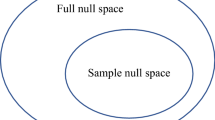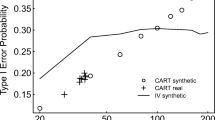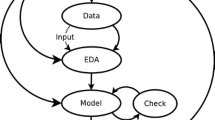Abstract
We evaluate a common reasoning strategy used in community ecology and comparative psychology for selecting between competing hypotheses. This strategy labels one hypothesis as a “null” on the grounds of its simplicity and epistemically privileges it as accepted until rejected. We argue that this strategy is unjustified. The asymmetrical treatment of statistical null hypotheses is justified through the experimental and mathematical contexts in which they are used, but these contexts are missing in the case of the “pseudo-null hypotheses” found in our case studies. Moreover, statistical nulls are often not epistemically privileged in practice over their alternatives because failing to reject the null is usually a negative result about the alternative, experimental hypothesis. Scientists should eschew the appeal to pseudo-nulls. It is a rhetorical strategy that glosses over a commitment to valuing simplicity over other epistemic virtues in the name of good scientific and statistical methodology.
Similar content being viewed by others
Notes
The language of “null hypothesis” comes from Fisher's single hypothesis testing procedure, and Neyman and Pearson objected to its use, but it has long been a part of Neyman–Pearson testing. See (Gigerenzer 2004).
John Beatty (1987) discusses the case of Kimura's neutral theory of molecular evolution as a null hypothesis with respect to Fisher's version of null hypothesis testing and explains why it is inappropriate.
We describe the statistical reasoning here in terms of experiments, but do not intend to exclude observational studies. When experiments are impractical, observational studies are done instead. In an experiment, participants are randomly assigned to the control or experimental group, while in an observational study, participants are selected by uncontrolled factors. Our account of statistical hypothesis testing extends to observational studies insofar as they employ the standard tools of statistical inference used in Neyman–Pearson testing. On the principles of designing an observational study and how to detect, minimize, and measure biases, see Rosenbaum (2005).
This is controversial and depends in part on how selection and drift are conceptualized. See Millstein (2017, Sect. 2) for an overview of the fault lines.
We thank Elliott Sober for raising this point.
Other model selection criteria exist, such as the Bayesian information criteria. While there are important differences between these selection criteria, our arguments here extend to them as well.
We have focused on simplicity because it is directly appealed to by the proponents of the behavior-reading and neutrality hypotheses to justify privileging them. But we can imagine another virtue being privileged at the cost of all others, generality for example, and we would be against its use as a way of treating two hypotheses asymmetrically and calling the more general one the ‘null’ just the same.
References
Bausman WC (2018) Modeling: neutral, null, and baseline. Philos Sci 84(4):414–435
Beatty J (1987) Natural selection and the null hypothesis. In: Dupre J (ed) The latest on the best. MIT Press, Cambridge
Beatty J (1997) Why do biologists argue like they do?”. Philos Sci 64((Proceedings)):S432–S443
Bell G (2000) The distribution of abundance in neutral communities. Am Nat 155(5):606–617
Call J, Tomasello M (2008) Does the chimpanzee have a theory of mind? 30 years later. Trends Cognit Sci 12(5):187–192
Chase JM, Leibold MA (2003) Ecological niches: linking classical and contemporary approaches. University of Chicago Press, Chicago
Cohen J (1988) Statistical power analysis for the behavioral sciences, 2nd edn. Routledge Academic, New York
Dacey M (2016) The varieties of parsimony in psychology. Mind Lang 31(4):414–437
Dienes Z (2008) Understanding psychology as a science: an introduction to scientific and statistical inference. Palgrave Macmillan, New York
Douglas H (2009) Science, policy, and the value-free ideal. University of Pittsburgh Press, Pittsburgh
Fitzpatrick S (2008) Doing away with Morgan’s Canon. Mind Lang 23(2):224–246
Fitzpatrick S (2017) Against Morgan’s Canon. In: Andrews K, Beck J (eds) The Routledge handbook of philosophy of animal minds. Taylor and Francis, Routledge
Fletcher L, Carruthers P (2013) Behavior-reading versus mentalizing in animals. In: Metcalfe J, Terrace HS (eds) Agency and joint attention. Oxford University Press, Oxford, pp 82–99
Forster M, Sober E (1994) How to tell when simpler, more unified, or less ad hoc theories will provide more accurate predictions. Br J Philos Sci 45(1):1–35
Gigerenzer G (2004) Mindless statistics. J Socio-Econo 33(5):587–606
Godfrey-Smith P (1994) Of nulls and norms. In: PSA: proceedings of the Biennial meeting of the Philosophy of Science Association
Gotelli NJ, Graves GR (1996) Null models in ecology. Smithsonian Institution Press, Washington DC
Halina M (2015) There is no special problem of mindreading in nonhuman animals. Philos Sci 82(3):473–490
Hare B, Call J, Tomasello M (2006) Chimpanzees deceive a human competitor by hiding. Cognition 101(3):495–514
Hubbell SP (2001) The unified neutral theory of biodiversity and biogeography. In: Levin SA, Horn HS (eds) Monographs in population biology. Princeton University Press, Princeton
Hubbell SP (2006) Neutral theory and the evolution of ecological equivalence. Ecology 87(6):1387–1398
Krupenye C, Kano F, Hirata S, Call J, Tomasello M (2016) Great apes anticipate that other individuals will act according to false beliefs. Science 354(6308):110–114
Levins R (1966) The strategy of model building in population biology. Amer Sci 54:421–431
Lloyd EA (2015) Adaptationism and the logic of research questions: how to think clearly about evolutionary causes. Biol Theory 10:1–20
Longino HE (2008) Values, heuristics, and the politics of knowledge. In: Carrier M, Howard D, Kourany J (eds) The challenge of the social and the pressure of practice: science and values revisited. University of Pittsburgh Press, Pittsburgh, pp 68–86
Lurz RW (2011) Mindreading animals: the debate over what animals know about other minds. MIT Press, Cambridge
MacArthur RH (1957) On the relative abundance of bird species. Proc Natl Acad Sci USA 43(3):293
Mayo DG, Spanos A (2006) Severe testing as a basic concept in a Neyman–Pearson philosophy of induction. Br J Philos Sci 57(2):323–357
Meketa I (2014) A critique of the principle of cognitive simplicity in comparative cognition. Biol Philos 29(5):731–745
Melis AP, Call J, Tomasello M (2006) Chimpanzees (Pan troglodytes) conceal visual and auditory information from others. J Comp Psychol 120(2):154
Millstein RL (2017) Genetic drift. In: Zalta EN (ed) The Stanford encyclopedia of philosophy, Fall 2017 edn. https://plato.stanford.edu/archives/fall2017/entries/genetic-drift/
Neyman J, Pearson ES (1933) The testing of statistical hypotheses in relation to probabilities a priori. In: Mathematical proceedings of the Cambridge Philosophical Society
Norton JD (2003) A material theory of induction. Philos Sci 70(4):647–670
Penn DC, Povinelli DJ (2007) On the lack of evidence that non-human animals possess anything remotely resembling a ‘theory of mind’. Philos Trans R Soc Lond B: Biol Sci 362(1480):731–744
Penn DC, Povinelli DJ (2009) On becoming approximately rational: the relational reinterpretation hypothesis. In: Watanabe S, Blaisdell AP, Huber L, Young A (eds) Rational animals, irrational humans. Keio University Press, Tokyo, pp 23–43
Penn DC, Povinelli DJ (2013) The comparative delusion: the “behavioristic/mentalistic” dichotomy in comparative theory of mind research. In: Metcalfe J, Terrace HS (eds) Agency and joint attention. Oxford University Press, Oxford, pp 62–82
Penn DC, Holyoak KJ, Povinelli DJ (2008) Darwin’s mistake: explaining the discontinuity between human and nonhuman minds. Behav Brain Sci 31(02):109–130
Povinelli DJ, Vonk J (2004) We don’t need a microscope to explore the chimpanzee’s mind. Mind Lang 19(1):1–28
Purves DW, Pacala SW (2005) Ecological drift in niche-structured communities: neutral pattern does not imply neutral process. In: Burslem D, Pinard M, Hartley S (eds) Biotic interactions in the tropics: their role in the maintenance of species diversity. Cambridge University Press, Cambridge, pp 107–138
Rosenbaum PR (2005) Observational study. In: Everitt BS, Howell DC (eds) Encyclopedia of statistics in behavioral science. Wiley, Chichester
Sani F, John T (2008) Experimental design and statistics for psychology: a first course. Wiley, Hoboken
Sedlmeier P, Gigerenzer G (1989) Do studies of statistical power have an effect on the power of studies? Psychol Bull 105(2):309
Sober E (1994) Let’s razor ockham’s razor. In: Sober E (ed) From a biological point of view: essays in evolutionary philosophy. Cambridge University Press, Cambridge, pp 136–157
Sober E (2002) Instrumentalism, parsimony, and the Akaike framework. Philos Sci 69(S3):S112–S123
Sober E (2005) Comparative psychology meets evolutionary biology: Morgan’s Canon and Cladistic Parsimony. In: Daston L, Mitman G (eds) Thinking with animals: new perspectives on anthropomorphism. Columbia University Press, New York, pp 85–99
Sober E (2009) Parsimony and models of animal minds. In: Lurz RW (ed) The philosophy of animal minds, p 237. Cambridge University Press, Cambridge
Staley KW (2017) Pragmatic warrant for frequentist statistical practice: the case of high energy physics. Synthese 194(2):355–376
Tilman D (1982) Resource competition and community structure. In: Levin SA, Horn HS (eds) Monographs in population biology. Princeton University Press, Princeton
Tilman D (1986) Resources, competition and the dynamics of plant communities. In: Crawley M (ed) Plant ecology. Blackwell Scientific Publications, Oxford, pp 51–75
Vellend M (2016) The theory of ecological communities. In: Levin SA, Horn HS (eds) Monographs in population biology. Princeton University Press, Princeton
Acknowledgements
Versions of this paper were presented at POBAM 2014 and SPSP 2015. We thank the audience for their questions and discussion. We would also like to thank Adrian Currie, Shay Logan, Helen Longino, Elliott Sober, Kent Staley, Jos Uffink, and C. Kenneth Waters for extensive comments and discussion. William Bausman’s writing of this article was supported in part by a grant from the John Templeton Foundation: #50191; From Biological Practice to Scientific Metaphysics.
Author information
Authors and Affiliations
Corresponding author
Rights and permissions
About this article
Cite this article
Bausman, W., Halina, M. Not null enough: pseudo-null hypotheses in community ecology and comparative psychology. Biol Philos 33, 30 (2018). https://doi.org/10.1007/s10539-018-9640-4
Received:
Accepted:
Published:
DOI: https://doi.org/10.1007/s10539-018-9640-4




